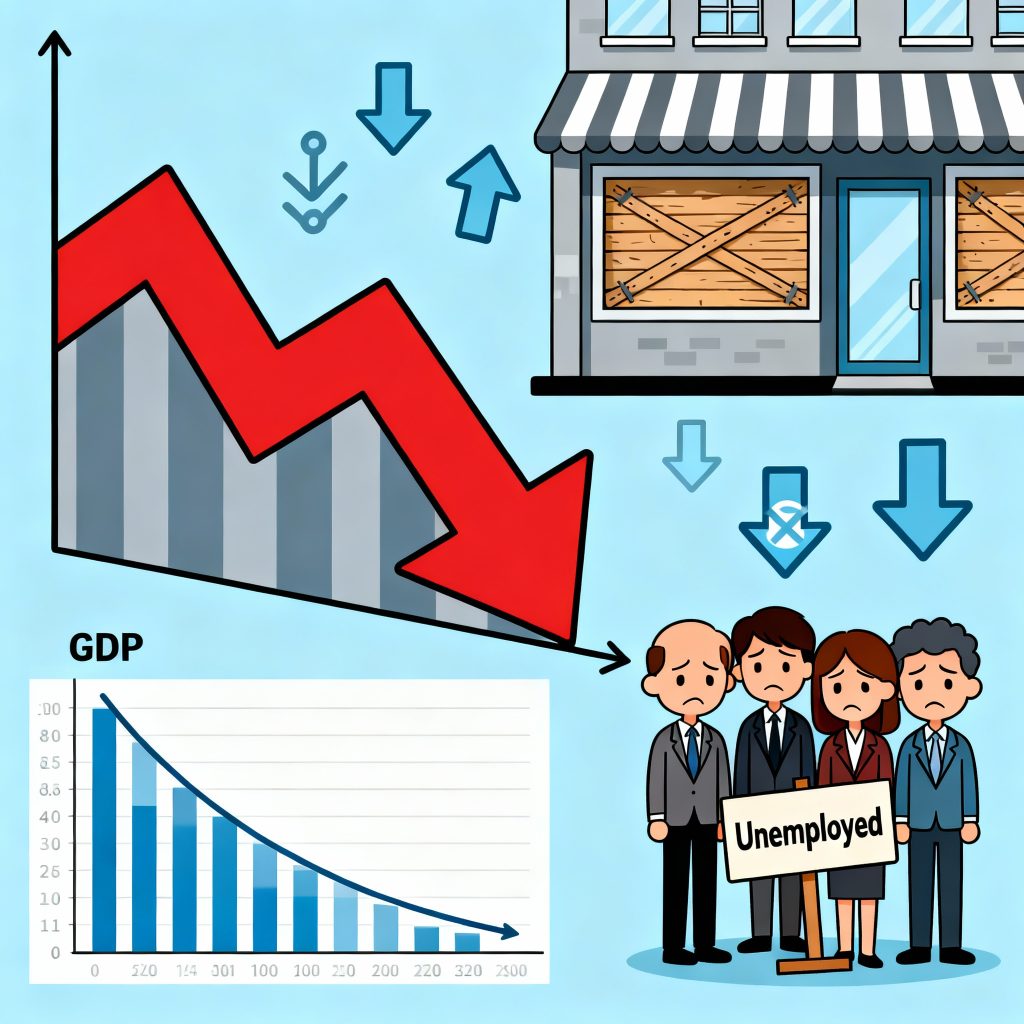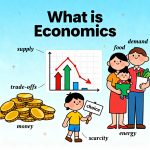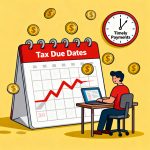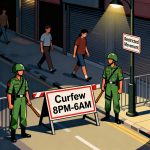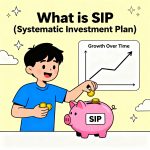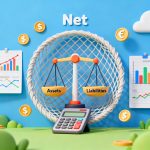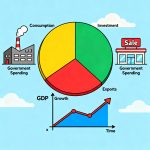Are you worried about headlines predicting a potential recession in 2025? With rising economic uncertainty, tariff concerns, and market volatility making news, understanding what is a recession has become more crucial than ever for young professionals, students, and entrepreneurs. A recession is a significant and widespread downturn in economic activity that typically lasts longer than a few months, affecting everything from job markets to investment opportunities. In simple terms, it’s when the economy shrinks instead of grows, impacting your career prospects, financial stability, and business decisions.
Understanding Recession: The Complete Definition
A recession represents a prolonged, broad, and significant decline in economic activity across multiple sectors of the economy. The National Bureau of Economic Research (NBER) defines a recession as “a significant decline in economic activity spread across the economy, lasting more than a few months, normally visible in production, employment, real income, and other indicators.”
While many people use the “two consecutive quarters of negative GDP growth” rule as a simple identifier, economists rely on much more comprehensive criteria. The NBER examines what economists call the “three Ds”: depth, duration, and diffusion across industries. This means the economic decline must be substantial enough, last long enough, and affect enough sectors to qualify as a true recession.
Understanding recession cycles helps young professionals make informed career decisions and entrepreneurs time their business strategies effectively. Historical data shows recessions occur roughly every 7-10 years, making them a natural part of economic cycles that savvy individuals can prepare for and potentially benefit from.
Key Indicators of Recession
Employment and Unemployment Rates
Rising unemployment often serves as the most visible recession indicator for young professionals and job seekers. During recessions, companies typically reduce hiring, freeze wages, and implement layoffs to cut costs. The unemployment rate can rise from 2-3 percentage points during severe downturns, making job competition more intense.
For recent graduates and career changers, understanding employment trends becomes crucial for timing job searches and career moves. Industries like hospitality, retail, and construction typically experience higher unemployment during recessions, while sectors like healthcare, education, and essential services often remain more stable.
GDP Decline and Economic Output
Gross Domestic Product (GDP) decline represents the most fundamental recession measurement. When GDP contracts for multiple quarters, it indicates the economy is producing fewer goods and services than before. This reduction affects business revenues, consumer spending power, and overall economic confidence.
Real GDP adjusts for inflation, providing a clearer picture of actual economic shrinkage. During the 2008 recession, U.S. GDP declined by approximately 4.3%, while the COVID-19 recession saw a sharp but brief 9.5% annualized decline in the second quarter of 2020.
Consumer Spending and Business Investment
Reduced consumer spending often triggers or accelerates recessions, as consumer expenditure represents 60-70% of economic activity in developed nations. When people cut back on purchases due to job insecurity or reduced income, businesses experience declining revenues and may reduce operations.
Business investment in equipment, technology, and expansion also drops significantly during recessions. Companies postpone major purchases and expansion plans, creating a cycle where reduced spending leads to lower production and employment, further reducing spending power.
Types of Recessions
Demand-Driven Recessions
Demand-driven recessions occur when consumer and business spending drops significantly, often due to confidence issues, credit restrictions, or external shocks. The 2008 financial crisis exemplifies this type, where housing market problems reduced consumer wealth and confidence, leading to widespread spending cuts.
These recessions typically respond well to monetary policy interventions like interest rate cuts and fiscal stimulus, as they address the underlying demand problem. For entrepreneurs, demand-driven downturns can present opportunities in essential services and value-oriented businesses.
Supply-Side Recessions
Supply-side recessions result from disruptions in production capacity, raw materials, or labor availability. The COVID-19 pandemic created a unique supply-side recession when lockdowns disrupted global supply chains and forced business closures regardless of demand levels.
These recessions prove more challenging to address through traditional monetary policy, as the problem lies in production capacity rather than spending willingness. Young professionals in logistics, technology, and essential services often find opportunities during supply-side disruptions.
Financial Crisis Recessions
Financial crisis recessions occur when banking systems face severe stress, restricting credit availability and creating broader economic problems. The 2008 Great Recession illustrates how mortgage market problems can spread throughout the entire financial system.
These recessions typically last longer and cause more severe economic damage, as credit restrictions affect both consumer spending and business investment. Understanding financial stability indicators helps investors and entrepreneurs prepare for these more severe downturns.
2025 Recession Outlook and Current Trends
Economic Uncertainty and Policy Impacts
Current economic uncertainty stems from various factors including trade policies, tariff implementations, and geopolitical tensions. President Trump’s tariff policies and trade negotiations create uncertainty that affects business planning and consumer confidence. Economists have increased recession probability estimates due to these policy-related uncertainties.
Interest rate policies also influence recession risk, with the Federal Reserve maintaining rates at 4.25-4.50% to balance inflation control with economic growth support. Higher rates can slow economic activity but also provide tools for future stimulus if needed.
Market Indicators and Warning Signs
Several economic indicators suggest heightened recession risk in 2025. Stock market volatility has increased, with major indices experiencing significant declines amid trade and policy concerns. The inverted yield curve, historically a reliable recession predictor, has signaled potential economic weakness.
Consumer confidence measures show mixed signals, with some surveys indicating optimism about personal finances but concern about broader economic conditions. Business investment has slowed in certain sectors, particularly those affected by trade uncertainties.
How Recessions Affect Different Groups
Impact on Young Professionals
Young professionals typically face disproportionate recession impacts, as entry-level positions often face the first cuts during economic downturns. However, recessions also create opportunities for those who prepare effectively. Companies may offer training programs, internships become more competitive but valuable, and career pivots become more feasible.
Wage growth typically slows during recessions, making salary negotiations more challenging. However, professionals with in-demand skills in technology, healthcare, and essential services often maintain better job security and advancement opportunities.
Effects on Students and Recent Graduates
Students entering the job market during recessions face what economists call “scarring effects”—long-term career impacts from starting careers during economic downturns. However, recessions also drive many individuals back to education, creating opportunities for skill development and career pivoting.
Graduate school applications typically increase during recessions as students seek to improve qualifications while waiting for job markets to recover. This trend can benefit those who use recession periods for education and skill development.
Opportunities for Entrepreneurs
Recessions create unique entrepreneurial opportunities despite overall economic challenges. Many successful companies, including Microsoft, Apple, and Airbnb, launched or achieved major growth during economic downturns. Reduced competition, lower startup costs, and increased talent availability can benefit well-prepared entrepreneurs.
Service businesses addressing recession-specific needs often thrive, including debt counseling, budget consulting, and essential services. Technology solutions that help businesses reduce costs or improve efficiency also find strong markets during economic downturns.
Recession Preparation Strategies
Building Financial Resilience
Financial preparation forms the foundation of recession readiness. Build emergency funds covering 6-12 months of expenses, prioritizing liquid savings over investments during uncertain periods. Pay down high-interest debt, particularly credit cards, to reduce financial obligations during potential income disruptions.
Diversify income sources where possible through side businesses, freelance work, or passive income streams. Multiple income sources provide better security if primary employment faces recession-related challenges.
Career and Skill Development
Invest in recession-resistant skills and industries during economic uncertainty. Healthcare, technology, education, and essential services typically maintain better stability during downturns. Pursue certifications, additional training, or degree programs that enhance recession-proof capabilities.
Network actively and maintain professional relationships, as personal connections often prove crucial for finding opportunities during challenging economic periods. Strong professional networks can provide job leads, collaboration opportunities, and business referrals.
Investment Strategy Adjustments
Adjust investment strategies to balance growth potential with recession protection. Maintain diversified portfolios including recession-resistant sectors like utilities, healthcare, and consumer staples. Consider defensive investments while maintaining some growth exposure for post-recession recovery.
Avoid panic selling during market downturns, as recessions typically create excellent long-term buying opportunities for patient investors. Historical data shows markets generally recover strongly following recession periods.
Ready to recession-proof your finances and career? Start by assessing your current financial position, building emergency savings, and developing recession-resistant skills. Remember, those who prepare effectively often emerge from recessions stronger and better positioned for future opportunities. Take action now by creating a comprehensive financial plan, expanding your professional network, and identifying potential opportunities that economic uncertainty might create in your field.
Frequently Asked Questions
How long do recessions typically last?
Most recessions last 6-18 months, though severity varies significantly. The average U.S. recession since World War II has lasted about 11 months. However, recovery to pre-recession employment and economic levels often takes 2-4 years, meaning the full economic impact extends beyond the official recession period.
What’s the difference between a recession and a depression?
A recession involves significant but temporary economic decline, while a depression represents a severe, prolonged economic downturn lasting several years. The Great Depression of the 1930s lasted nearly four years with GDP declining over 25%. Modern economic policies and institutions make depressions much less likely than recessions.
Can recessions be predicted accurately?
While economists identify risk factors and warning signs, precisely timing recessions remains extremely difficult. Indicators like inverted yield curves, declining consumer confidence, and reduced business investment suggest increased risk, but many predicted recessions never materialize, and some recessions occur without clear advance warning.
How do government policies help during recessions?
Governments typically respond with fiscal stimulus (increased spending, tax cuts) and monetary policy (lower interest rates, increased money supply). These policies aim to boost spending, encourage investment, and stabilize financial markets. However, policy effectiveness depends on recession causes and implementation timing.
Should I change my investment strategy during a recession?
Avoid panic selling, as recessions often create excellent long-term buying opportunities. Consider maintaining diversified portfolios with some defensive positions while keeping growth investments for recovery periods. Focus on quality companies with strong balance sheets that can survive economic downturns and benefit from eventual recovery.
